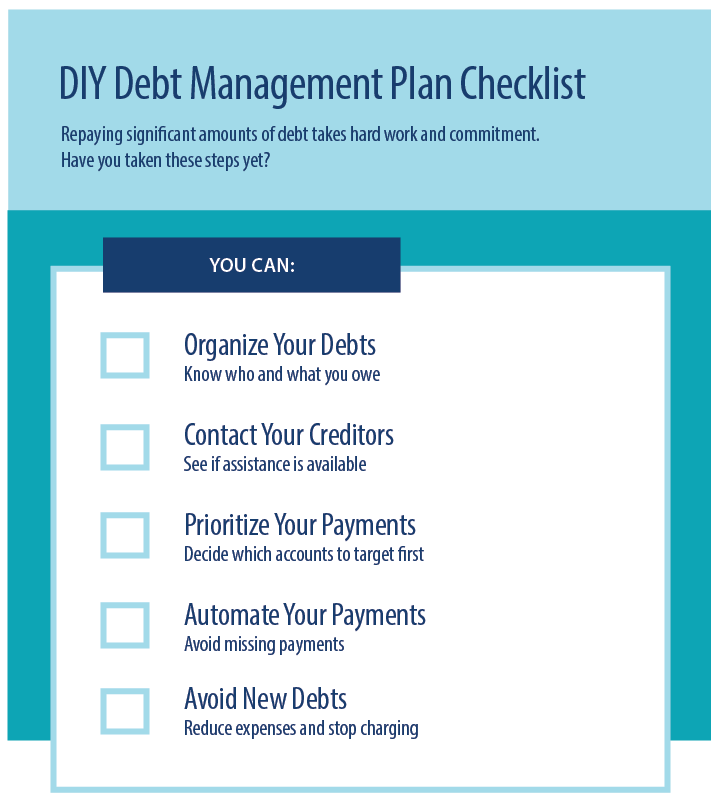Leading Benefits of Debt Combination for Managing Your Funds: More Discussion Posted Here
Leading Benefits of Debt Combination for Managing Your Funds: More Discussion Posted Here
Blog Article
Whatever You Required to Find Out About Developing an Individualized Debt Administration Strategy
In the world of individual finance, creating a tailored debt monitoring strategy is typically the cornerstone of accomplishing economic stability and tranquility of mind. As you navigate the complexities of creating a customized financial debt monitoring plan, comprehending the intricacies of each action is essential to your economic success.
Evaluating Your Present Financial Debt Scenario
One must initially conduct a thorough analysis of their current financial debt commitments prior to developing an efficient financial debt administration strategy. Create a thorough list of each debt, including the total quantity owed, rate of interest rates, minimum regular monthly repayments, and due dates.
After compiling this information, compute your total debt-to-income ratio by splitting your regular monthly financial debt repayments by your month-to-month revenue. This ratio is a key indication of your ability to manage present debt degrees effectively. Furthermore, evaluate your credit report to recognize any type of mistakes or disparities that might be affecting your credit report. Understanding these elements of your economic situation will guide you in developing an individualized financial obligation monitoring strategy customized to your specific requirements and objectives.
Setup Financial Goals and Targets

When setting financial objectives, it's vital to be details, quantifiable, achievable, relevant, and time-bound (WISE) For instance, you might establish a goal to settle a particular amount of financial obligation within a specific time structure, such as reducing your charge card equilibrium by $5,000 in the next twelve month - More Discussion Posted Here. By setting clear targets like this, you can track your progression and stay inspired to attain your financial debt administration objectives
Furthermore, take into consideration prioritizing your debts based upon elements such as rate of interest, outstanding equilibriums, and settlement terms. By focusing on high-interest financial obligations first, you can conserve money in the long run and increase your trip toward financial flexibility. Bear in mind, everyone's monetary situation is distinct, so customize your targets and objectives to fit your specific needs and circumstances.
Developing a Realistic Budget
Crafting a distinct spending plan is a fundamental action in effective financial obligation administration and financial preparation. A realistic budget works as a roadmap for your monetary wellness, helping you track your income, expenses, and financial obligation payments. To develop a functional spending plan, beginning by providing all your income sources. This includes your wage, side rush profits, or any kind of various other financial inflows. Next off, magazine all your taken care of expenditures such as rental fee or home mortgage, energies, insurance, and financing settlements. Variable expenditures like grocery stores, enjoyment, and transportation ought to also be included. Differentiate between requirements and wants to prioritize important costs and determine locations where you can cut down.
When setting budget plan limits, be straightforward with yourself about your spending behaviors and monetary obligations. Assign a portion of your revenue towards repaying debt while guaranteeing you have some funds for emergency situations and savings. Consistently testimonial and adjust your budget plan as required to remain on track with your monetary goals and financial obligation settlement plan. By sticking to a practical spending plan, you can properly manage your debt and job towards a much more secure financial future.
Checking Out Financial Debt Settlement Approaches
After establishing a reasonable spending plan, the following critical step in effective financial obligation monitoring is to explore numerous financial debt settlement strategies. One usual method is the snowball technique, where you concentrate on settling the smallest financial debts initially while making minimum repayments on bigger debts. This approach can assist develop energy as you see smaller financial debts being removed, giving motivation to take on bigger ones.
An additional approach is the avalanche technique, which entails focusing on financial debts with the highest possible rates of interest. Check This Out By targeting high-interest financial obligations first, you can decrease the overall quantity you pay in passion with time. This technique may be much more cost-effective in the future, despite the fact that it could take longer to see specific financial debts fully paid off.
Debt combination is one more choice where you combine multiple financial debts into a single lending with a reduced rate of interest. This can streamline your payment process and possibly minimize the overall rate of interest paid. Nonetheless, it's crucial to very carefully consider the costs and terms connected with combination to guarantee it's the right option for your monetary situation.
Tracking and Readjusting Your Strategy

Changing your plan may entail reallocating funds to tackle high-interest financial obligations initially, negotiating with lenders for lower rate of interest or better payment terms, or discovering added revenue sources to accelerate financial obligation payment. As your monetary circumstance advances, your debt management plan ought to adapt accordingly to remain effective. By staying proactive and flexible in tracking and changing your plan, you can enhance your initiatives towards settling your financial obligations effectively and accomplishing your economic objectives.
Verdict
To conclude, creating a tailored financial obligation administration plan entails examining existing financial obligation, setting economic goals, creating a reasonable budget, discovering payment strategies, and monitoring and readjusting the plan as required. By complying with these steps, people can take control of their monetary situation and job towards coming to be debt-free. It is important to stay Recommended Reading self-displined and dedicated to the strategy in order to attain long-term economic stability.
One have to first conduct a complete examination of their current financial debt responsibilities before creating an effective financial debt management plan.After developing a reasonable budget, the following crucial step in effective financial obligation management is to explore different financial debt repayment methods - More Discussion Posted Here.To effectively handle your financial debt, continuous tracking and change of your financial debt management plan are crucial components for long-term economic stability.Changing your plan might involve reallocating funds to deal with high-interest financial debts first, discussing with financial institutions for lower rate of interest prices or far better payment terms, or exploring extra earnings sources to accelerate debt payment.In final thought, developing a customized financial obligation monitoring plan involves assessing current debt, setting financial goals, developing a sensible budget, exploring repayment techniques, and tracking and adjusting the plan as needed
Report this page